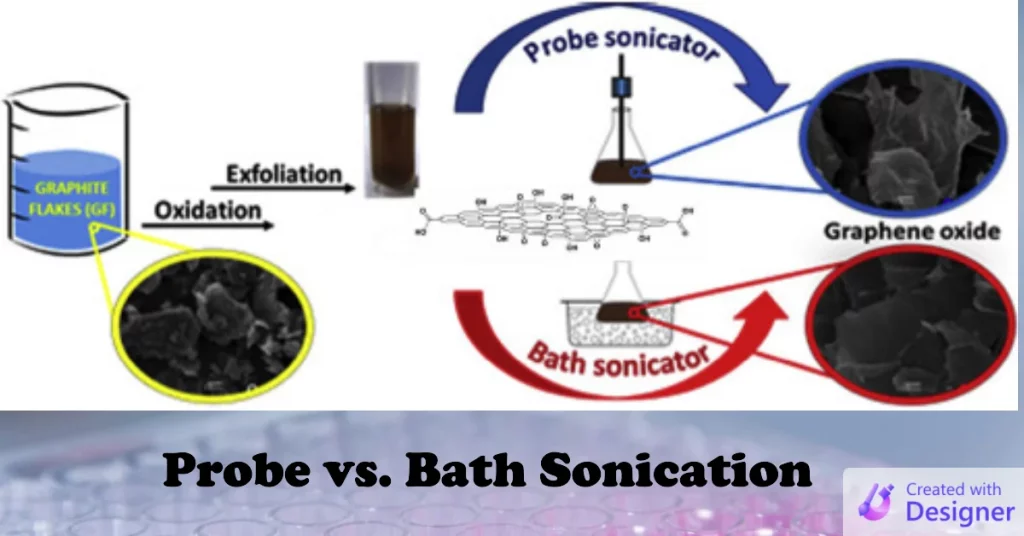What is Difference Between Probe Sonicator and Bath Sonicator

Have you ever wondered how scientists break apart tiny cells to study what’s inside? They use a cool technique called sonication! Sonication is a bit like giving cells a sound bath, and it plays a big role in biology and research. Probe sonicators deliver ultrasonic waves directly to the sample, while bath sonicators deliver ultrasonic waves to the sample through a water bath.
Now, not all sonic baths are the same. There are two main “flavors” of sonicators – the Probe Sonicator and the Bath Sonicator. Imagine using a focused sound wand to target a specific spot; that’s the Probe Sonicator for you. On the other hand, the Bath Sonicator is like dipping your cells into a sound spa, letting them all experience the vibes together.
Intrigued? Let’s dive deeper and explore the fascinating world of sonicators!
What is a Probe Sonicator?
A Probe Sonicator is a bit like a magic wand, but for science. Instead of casting spells, it uses sound waves to break apart samples. Here’s a closer look:

Key Features of Probe Sonicator:
- Direct Contact: The probe directly touches the sample, sending powerful sound waves right where you want them.
- Adjustable Intensity: You can change how strong the sound waves are, depending on what you’re working with.
- Versatile: It can handle different sample volumes, from tiny droplets to bigger batches.
- Cooling Systems: Some probe sonicators come with cooling systems. Why? Because things can get a bit heated with all those sound waves!
Common Applications:
- Breaking apart tough cell walls or tissues.
- Mixing hard-to-mix solutions.
- Making tiny particles called nanoparticles.
Advantages of Probe Sonication
When it comes to shaking things up at the microscopic level, the Probe Sonicator is like the superhero of the lab. Why? Here are some of its superpowers:
- Precision and Control: With a Probe Sonicator, you’re in the driver’s seat. You get to decide exactly where and how much energy goes into your samples. It’s like using a fine-tipped paintbrush, where you can paint detailed strokes with precision.
- Versatility with Sample Volumes: Whether you have a tiny sample or a bigger batch, the Probe Sonicator is up for the challenge. It’s like having a kitchen mixer that can whip up both a single cupcake or a whole batch without a hitch.
- Direct Energy Delivery: Imagine trying to pop a balloon by throwing a dart from a distance versus poking it up close. The Probe Sonicator is that close-up poke, delivering energy straight to the heart of the sample for efficient results.
Limitations of Probe Sonication
However, every superhero has its kryptonite, and the Probe Sonicator is no exception. Here are some challenges to keep in mind:
- Risk of Contamination: Because the probe directly touches the sample, there’s a tiny chance of unwanted stuff getting in, especially if not cleaned properly. It’s like using the same spoon for different dishes without washing it.
- Potential Overheating: All that energy can sometimes make samples a bit too hot to handle. It’s essential to keep an eye on the temperature, especially with heat-sensitive samples.
- Noise: Let’s face it, the Probe Sonicator can be a bit loud. It’s like having a mini concert in the lab. Some folks even consider soundproofing or using ear protection to keep things comfortable.
Also Read What is the Difference Between Sentient and Sapient
What is a Bath Sonicator?
Imagine giving your samples a relaxing bath, but instead of water, they’re surrounded by sound. That’s the Bath Sonicator for you! The term “ultrasonic bath” is most commonly used to refer to a type of bath sonicator. A bath sonicator is a device that uses ultrasonic waves to clean or degas samples. The ultrasonic waves are generated by a transducer that is placed at the bottom of the bath.

Key Features of Bath Sonicator:
- No Direct Contact: The beauty of this is that there’s no probe touching your sample, reducing the risk of any mix-ups or contamination.
- Multiple Samples: Got a lot to work on? No problem! You can put multiple samples in at once.
- Uniform Sound Waves: Every part of your sample gets the same amount of sound love, ensuring even results.
- Gentler Approach: It’s less intense than the probe, making it perfect for more delicate samples.
Common Applications:
- Giving cells a gentle shake-up.
- Defrosting or degassing solutions.
- Prepping samples for other experiments.
Advantages of Bath Sonication
Imagine a serene spa day, but for your lab samples. That’s what the Bath Sonicator feels like. It’s gentle, encompassing, and perfect for those looking for a more relaxed approach to sonication. Let’s delve into its strengths:
- Multi-tasking with Multiple Samples: Got a bunch of samples? No worries! The Bath Sonicator is like the multitasker of the lab world. You can drop in several samples at once, and let them all enjoy the sonic spa treatment together.
- No Direct Contact, Less Contamination: One of the best things about the Bath Sonicator is that it doesn’t touch your samples directly. Think of it as cooking with a steamer; the heat (or in this case, sound) gets to your food industry, but the water doesn’t. This means less chance of unwanted things getting into your precious samples.
- Gentle and Even Sonication: The Bath Sonicator is like a gentle lullaby for your samples. It ensures that every part of your sample gets an equal dose of sound waves, making for a more uniform result.
Limitations of Bath Sonication
But, as with everything, the Bath Sonicator has its challenges. Here’s what to watch out for:
- Less Power Punch: While it’s gentle, the Bath Sonicator might not pack the same power punch as the Probe Sonicator. It’s like comparing a light drizzle to a thunderstorm. Both are forms of rain, but one is definitely more forceful than the other.
- Not for the Stubborn Samples: Some samples are a bit like stubborn knots in a shoelace; they need a bit more force to break apart. The Bath Sonicator might not always be up to this challenge.
- Patience is Key: With the Bath Sonicator, things might take a tad longer. It’s a trade-off between its gentleness and speed. If you’re in a hurry, this might not be the quickest route to your destination.
Comparative Analysis: Probe vs. Bath Sonication

The world of sonication offers two prominent players: the focused Probe Sonicator and the encompassing Bath Sonicator. While both have their unique strengths, understanding their differences can help you choose the right tool for your tasks. Let’s pit them head-to-head and see how they fare.
1. Efficiency:
- Probe Sonicator: This is the powerhouse. With its direct contact, it delivers energy straight to the sample, breaking apart even the most stubborn of cells or particles. Think of it as the sprinter who dashes straight to the finish line.
- Bath Sonicator: It’s the marathon runner. While it might take a bit longer to achieve the same results as the probe, it ensures a consistent and even energy distribution to all samples. It’s all about pacing and uniformity.
2. Application:
- Probe Sonicator: Ideal for tasks that require a lot of power or precision. If you’re dealing with tough-to-break materials or need specific targeted sonication, this is your go-to. It’s the surgeon of the sonication world.
- Bath Sonicator: Perfect for general applications where gentleness or simultaneous processing of multiple samples is a priority. It’s like the general practitioner who takes care of a variety of needs.
3. Usability:
- Probe Sonicator: While it offers precision, it might require more hands-on attention. There’s also the need for regular cleaning of the probe to avoid contamination.
- Bath Sonicator: Drop your samples in, set the time and intensity, and let it do its thing. It’s more of a set-it-and-forget-it approach, making it user-friendly for many.
Factors to Consider When Choosing:
- Nature of Your Sample: Delicate samples might benefit from the gentleness of a bath sonicator, while tougher ones might need the power of a probe.
- Volume: If you’re processing many samples simultaneously, the bath sonicator has the edge. But for individual, precise work, the probe is unparalleled.
- Time: In a hurry? The probe might be faster for quick results. But if you have the time and prefer an even, gentle approach, the bath sonicator shines.
- Contamination Concerns: Regular cleaning and maintenance of the probe can mitigate contamination risks. However, if you want to minimize direct contact, the bath sonicator stands out.
- Noise Levels: If you’re in a setting where noise could be an issue, remember the probe sonicator can be louder. You might need to consider soundproofing or earmuffs.
What are the Similarities Between Probe Sonicator and Bath Sonicator?
- Sonication Method: Both use sound waves to process samples.
- Sample Treatment: They are used for treating biological samples.
- Sonication Benefits: They provide benefits like mixing, size reduction, and cell lysis.
- Lab Equipment: Both are commonly found in laboratories.
- Scientific Advancements: They contribute to scientific progress in various fields.
Bottom Line
After exploring the world of sonication and comparing the Probe Sonicator and the Bath Sonicator, let’s recap the key differences and similarities to help you make an informed decision.
The Probe Sonicator shines with its precision, power, and direct contact, making it ideal for tasks requiring targeted sonication. It offers efficiency for breaking apart tough samples but comes with the risk of contamination and potential overheating.
On the other hand, the Bath Sonicator offers a gentle and uniform approach, perfect for multiple samples simultaneously. It reduces the risk of contamination, requires less hands-on attention, but might be less powerful and take longer to achieve the same results.
When choosing the right sonicator for your needs, consider the nature of your sample, the volume of samples, time constraints, contamination concerns, and noise levels in your lab environment. Each sonicator has its strengths that can be leveraged based on specific requirements.
Remember, the Probe Sonicator is like a precision tool, suitable for targeted applications that demand power and control. The Bath Sonicator, with its gentle and encompassing nature, is ideal for general tasks where uniformity and simultaneous processing are priorities.
Ultimately, the choice between the two sonicators depends on your specific needs and preferences. By considering the factors mentioned, you can confidently select the sonicator that will best serve your scientific endeavors.
Check refence https://en.wikipedia.org/wiki/Sonication
Happy sonication and may your experiments yield exciting results!
FAQ’s
Probe sonicators utilize direct contact between the probe tip and the sample to transfer sound energy, while bath sonicators use the water bath to transmit the sound waves to the sample. Probe sonicators offer more control and precision since the tip can be focused on specific areas, while bath sonicators are better suited for larger volume samples.
Probe sonicators are commonly used in laboratories for cell disruption, nanoparticle dispersion, extraction, and sample preparation. Their precise control allows for efficient processing of small samples and delicate materials.
Bath sonicators are widely used in laboratories and industrial settings for degassing, cleaning, mixing, and particle dispersion. They are suitable for larger volume samples and continuous operations.
Yes, the probe tip of a probe sonicator can typically be replaced. This allows for customization based on the specific application and sample type. Different probe tips may have varying shapes, sizes, and materials to optimize sonication results.
The key parameters include frequency (commonly 20 kHz), amplitude (vibration intensity), power (wattage), and process time. These parameters can be adjusted based on the specific sample and desired sonication results.
Always wear hearing protection when using a sonicator. Sonicators emit high-frequency sound waves that can damage your hearing. You should also use a sonicator in a well-ventilated area, as sonication can create aerosols that can be harmful if inhaled. Do not operate a sonicator in the presence of flammable or combustible materials, as the ultrasonic waves can create sparks, which could start a fire. Finally, do not leave a sonicator unattended, as it could overheat or start a fire if it is not properly monitored.



